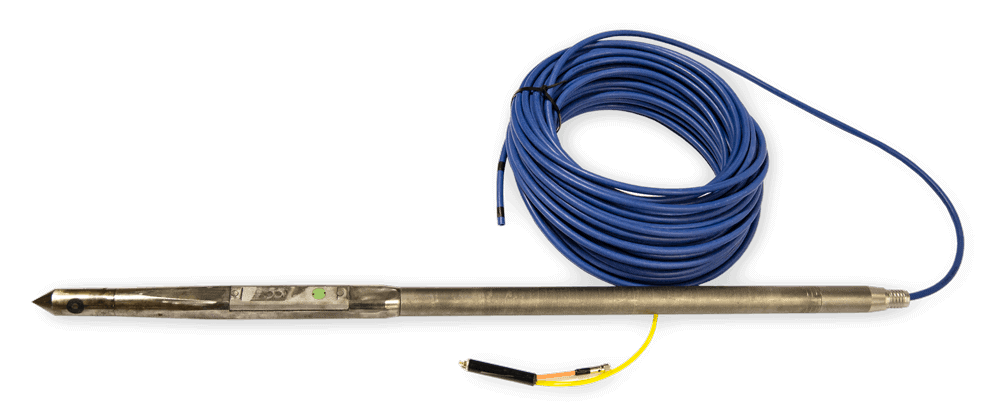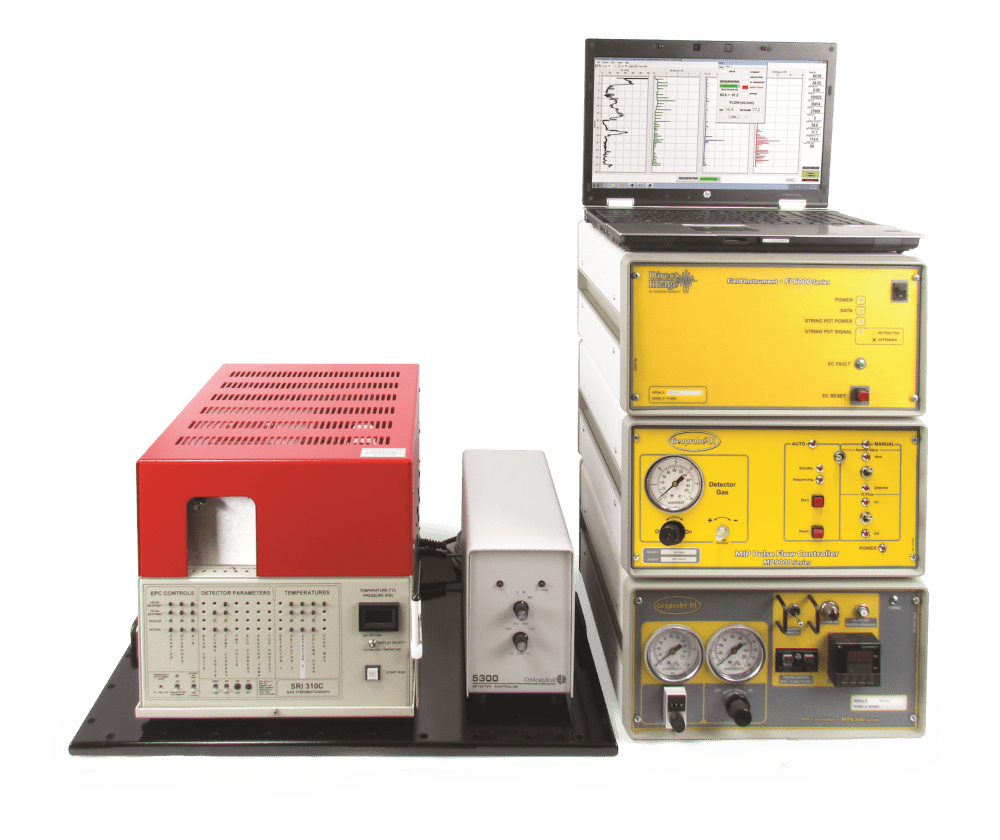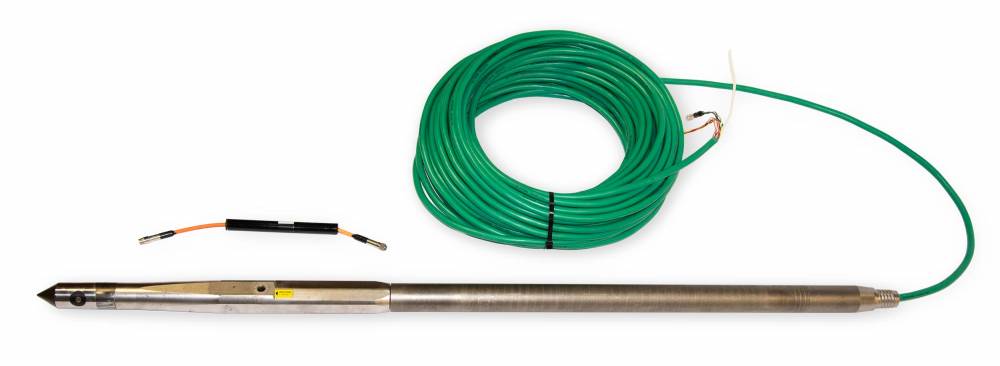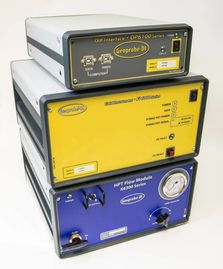
MIP
Membrane Interface Probe – The MIP is a logging tool that measures Volatile hydrocarbon and solvent contamination along with soil electrical conductance and permeability. It then shows distribution and relative magnitude of both halogenated and non-halogenated VOC contaminants to work with both saturated and unsaturated soils.
An inert carrier gas is continually swept behind a heated membrane in the probe, delivering it to a series of detectors at the surface. The detectors each respond to different analyte properties which allows the MIP operator to discern the contaminant to its family group as well as provide the ability to map out the contaminant plume from source to extent. Obtaining an understanding of soil conductance and permeability along with the contaminant information allows the user to know if the VOC contamination is near to prominent migration pathways or bound up in a storage zone.
The MIP is the only tool capable of logging VOCs in situ within real-time. It determines contaminant mobility and migration pathways, detects contaminants in both coarse and fine-grained soils and generates real-time contaminant screening information. This feature allows field adjustment of the site investigation.

HPT
Hydraulic Profiling Tool - This logging tool allows us to measure the pressure required to inject a flow of water into the soil as the probe is advanced into the subsurface. It produces a detailed log of relative formation pemeability which can be used to estimate hydraulic conductivity in an over contaminated zone.
This tool can log HPT injection pressure, flow rate and electrical conductivity. It uses pressure dissipation tests to measure hydrostatic pressure. The HPT also determines piezometric profile and water table depth and can be used to map salt and brine contaminant plumes.

MIHPT
Membrane Interface & Hydraulic Profiling Tool – The MIHPT probe is a specialized, combined tool used to detect and determine volatile organic compounds (VOCs), soil permeability, and soil type/lithology all in one push. Volatile compounds diffuse through the MIP Membrane and a carrier gas transports the VOCs “up-hole” to detectors on the surface. The HPT system monitors the necessary pressure to maintain a constant injection. We can measure accurate water level data and estimate hydraulic conductivity from this information. Lastly, the Electrical Conductivity Dipole Array emits a current through the subsurface formation in between the two probe contacts. This current and the resulting voltage is measured and soil type can be determined by its conductivity.

LL-MIP
Low Level Membrane Interface Probe — The LL-MIP operates in a similar manner to our normal MIP tool, however, the LL-MIP enhances detector sensitivity by a factor of approximately 10. LL-MIP operation is beneficial in situations where the standard MIP detector signals have reached practical limits.
The main feature of this technology is to pulse the carrier gas stream that sweeps the internal surface of the MIP membrane. VOC contaminant concentration that is delivered to the MIP detectors is then increased.

OIP
Optical Image Profiler - This tool produces a detailed log of induced fuel fluorescence. It contains a downhole camera that operates at 30 frames per second (fps) to capture fuel fluorescence. Our acquisition software will then analyze each image for typical fuel fluorescence color.
The results are the percent of the image area (up to 100%) that displays fuel fluorescence. Fluorescence images are saved in the log every 0.05ft (15mm) for review at a later time.
OIP log Interpretation is intuitive, made simple by the saved images to compare to the log. The OIHPT-UV probe contains both 275nm UV and visible LEDs. The OIHPT-G probe contains both 520nm LD and infrared LEDs. With this tool, we're able to automatically and manually capture visible soil images.

OIHPT
Optical Image Profiler & Hydraulic Profiling Tool – The OIHPT is a specialized, combined tool that allows us to detect LNAPL products, test soil permeability, and understand soil type/lithology before your remediation phase. Rather than a MIP Membrane, the OIHPT tool has an OIP Window used to detect UV induced fluorescence of LNAPL products in soil (petroleum hydrocarbons). UV light emitted from the window causes LNAPL to fluoresce. Images of the soil are captured at a rate of 30 frames per second, displayed up-hole and analyzed for fluorescence. The camera can also capture visual images. Like the MIHPT, the OIHPT also contains a Hydraulic Profiling tool and an Electrical Conductivity dipole.
OIHPT-G
Green light OIP tool — This tool operates in a similar manner to the OIHPT & OIP tools However, it also uses a green laser diode to induce fluorescence in contaminants such as Creosote, Coal Tars, Heavy Crude Oils, and Bunker Fuels.
This helps to fluoresce common organic contaminants that yield inconsistent results with standard UV light (coal tars, creosote, bunker fuels).

3D-Modeling & Visualization
Data obtained from our HRSC tools will allow us to create 3-D subsurface maps to better help you make critical decisions during your remediation phase!
Discrete Groundwater Sampling Tool
Discrete groundwater sampling tool — Once HRSC imaging logs have depicted zones, this tool allows us the ability to take discrete samples in necessary hot spots.
Quantitative Soil Sampling
Because of our lab affiliations, we are also able to offer quantitative sampling data from soil analysis at no additional cost.
